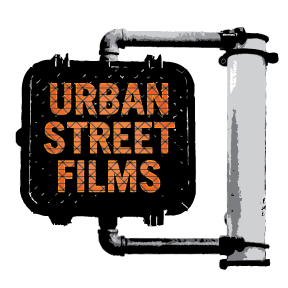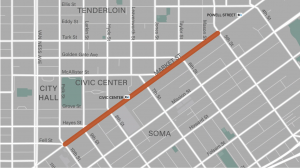5 Blocks Documentary on San Francisco’s Central Market Street
Asks, “Can A Neighborhood Work for Everyone?”
There are 5,321 blocks in the city of San Francisco. In 2011 filmmakers Dan Goldes and the late Robert Cortlandt focused their lenses on just five of them – the blocks between Fifth and 10th streets on Market Street. The result is the new documentary, 5 Blocks.
5 Blocks takes a dispassionate look at the Central Market Street neighborhood where income disparity and changing demographics pose one of the most challenging questions facing major cities across the U.S.: Is it possible to create a neighborhood that works for everyone?
Over the course of eight years and through dozens of interviews including the 16 individuals featured in the film, Goldes and his co-producer and director, Cortlandt, become all too familiar with the haunting beauty of San Francisco’s Market Street, once the grandest boulevard in America, and its gritty present.
The impetus for the documentary is the implementation of a Central Market Street Economic Strategy and with it the enactment of the Central Market Street and Tenderloin Payroll Expense Tax Exclusion in May 2011. The so-called Twitter tax break exempted companies moving into certain buildings in the Central Market Street corridor from the city’s payroll tax. Along with other measures, the Economic Strategy and payroll tax break were intended to bring economic stability and development to a long downtrodden neighborhood.
“I got wind of the revitalization after finishing my first film, the short documentary, ub2. I probably didn’t realize what I was getting into, I just knew that the concept – trying to revitalize an area that had resisted many previous attempts – seemed like something that should be documented,” says Goldes.
As Goldes soon realized, it was indeed more than he had expected and yet such a compelling story, he and Cortlandt had to follow it to at least the next chapter. While the project briefly stalled when Cortlandt developed cancer and died in 2016, Goldes would eventually continue pursuing the story on his own and the film is dedicated to Cortlandt’s memory.
“I made the film because I wanted to show how complex something like revitalizing a neighborhood is. People think of city planning as an organized, linear process that goes through city departments and commissions, but the way cities really change is through hundreds of small decisions made every day by all kinds of people. It’s a messy, non-linear, far from black-and-white process. I’m not sure people really understand that,” Goldes continues.
Interweaving cinema verité scenes, interviews with 16 individuals, and 75 pieces of archival film and photos showing the area from 1847 through the early 1970s, 5 Blocks reveals the challenges of balancing the needs of new businesses with the existing community. New residents are moving into newly built, high-end condos in the area as many long-time residents still live in tiny, cramped, subsidized hotel rooms built in the 1900s. Out of necessity, the wide sidewalks of Market Street have become almost an extension of their restricted living space.
Conflict is inevitable. While housing stock is protected, there is no protection for the inexpensive stores and restaurants that these SRO (single room occupancy) residents have relied on for decades. Non-profits who have called the area home for years begin to feel the squeeze, too, as do many of the arts-related organizations in the neighborhood, and yet as the film progresses, everyone involved wants to see less crime, cleaner streets and an end to open drug use.
Among those interviewed for the documentary are Sylvester Guard, a 35-year-old African American artist who lives in a 10×10-foot residential hotel room with no bathroom or kitchen; Amy Cohen, a city employee charged with leading efforts to change the neighborhood, and Mikkel Svane, founder and CEO of a tech company that has moved into the neighborhood to take advantage of the payroll tax break enacted by Mayor Edwin M. Lee in 2011.
Film highlights include former American Conservatory Theatre (A.C.T) Artistic Director Carey Perloff’s recalling the first time she entered what would become A.C.T.’s gem-like, 283-seat Strand Theater. “When we first walked in here to look at the Strand, it was really like an archaeological dig. There were dead birds all over the place, remnants of squatters upstairs and graffiti all over the walls … it was a totally abandoned space.”
As part of an “arts strategy” which includes the formation of the Community Arts Stabilization Trust (C.A.S.T.), some 15 new arts venues eventually open in the Central Market Street neighborhood, according to Cohen. Mayor Lee tells attendees at the ribbon-cutting ceremony for The Strand, “You know, as much as I appreciate technology, it was the arts that took all the risk,” by coming into the neighborhood years earlier. “Everyone talks about the digital divide. The arts can bridge the human divide,” adds neighborhood advocate Elvin Padilla.
Cohen, who is interviewed from the inception of the documentary, confirms Goldes’ perception of the “hundred small decisions” that will transform the neighborhood: “What I’ve learned is that it’s not one thing. The stuff that is not physical is going to take a lot more work.”
And in the closing minutes of the film as individuals look to the future, artist Guard sums up what many residents believe: “This neighborhood deserves a change. The people down here deserve a way to change with it. Some of us do still have dreams. Some of do want to move forward. I want to grow with the success that is coming out of here … I don’t want pity. I want opportunity.”
5 Blocks is Goldes’ first long-form film. Previous films have included documentary shorts, running five minutes or shorter. They have, collectively, screened at more than 100 film festivals around the world. From concept to screen, 5 Blocks took more than eight years and was supported by nearly 200 individuals in addition to local foundation, government, and corporate support.
Archival film and photo sources for the documentary include Premiere Pictures International (San Francisco,), the Prelinger Archives, the San Francisco Public Library’s Historic Photograph Collection, the California State Archive, the California Historical Society, the Western Sonoma County Historical Society, the National Park Service, the “San Francisco Chronicle,” San Francisco Municipal Transportation Agency, Market Street Railway, the Library of Congress, the National Archives, and several private collections.
Central Market Street Before and After
In 2011, 31 percent of households in a study area* bounded by Van Ness, Geary, Powell/Fifth Street and Howard, which included the Central Market Street neighborhood, lived on $15,000 or less annually. In some parts of the study area, between one-third and one-half of the residents lived in what is defined as extreme poverty. The retail vacancy rate was 30 percent and the office vacancy rate was 50 percent. Since 2011, 4,333 housing units have been built in the neighborhood with 25 percent of them defined as affordable. 10,000 new employees now work in the neighborhood. The commercial vacancy rate dropped to 4 percent.
*The study was done for the Central Market Economic Strategy.
Interviews (in alphabetical order)
•David Addington, former owner, Warfield Theatre
•Amy Cohen, Director, Neighborhood Program Development, San Francisco Office of Economic and Workforce Development
•Carolyn Diamond, Executive Director, Market Street Association (now retired)
•Mark Ellinger, neighborhood resident and photographer (Mark died on Oct. 4, 2019)
•Sylvester Guard, neighborhood resident and artist
•Neil Hrushowy, former Manager, City Design Group, San Francisco Planning Department
•Jake Levitas, former Research Director, Gray Area Foundation for the Arts
•Elvin Padilla, neighborhood advocate
•Ellyn Parker, former Senior Community Development Specialist, San Francisco Office of Economic and Workforce Development
•Carey Perloff, Artistic Director, American Conservatory Theater (now retired)
•Tim Redmond, Editor, 48Hills.org
•Jasper Rubin, Ph.d., Associate Professor of Urban Studies and Planning, San Francisco State University
•Randy Shaw, Executive Director, Tenderloin Housing Clinic
•Mikkel Svane, Founder and CEO, Zendesk
•Jeffrey Tumlin, Principal and Director of Strategy, Nelson\Nygaard (now Director of Transportation, City and County of San Francisco)
•Tania Zapata, neighborhood resident and entrepreneur
Help Share 5 Blocks!
Many community groups and advocacy organizations want to screen 5 Blocks but can’t afford the screening fee. Your tax-deductible donation can help cover these fees for groups doing important work. To donate, click the button below. Thank you!

